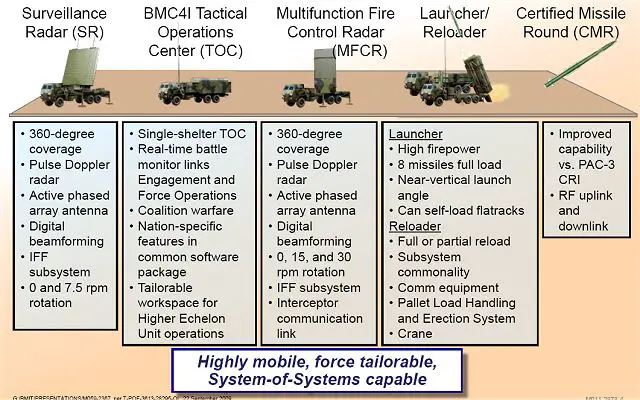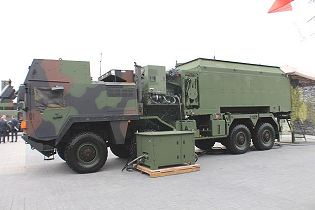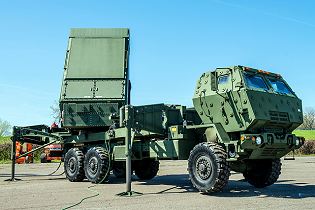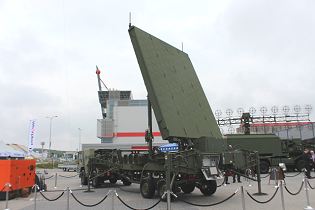- Army
- Air Defense Systems
- Anti-tank systems and vehicles
- Armored Vehicles
- Armoured personnel carriers
- Artillery Vehicles and Weapons
- Command Post
- Communication Vehicles and Systems
- Electronic Warfare
- Engineer | Maintenance Vehicles
- Infantry Fighting Vehicles
- Main Battle Tanks
- Missiles
- Tactical and Logistic Vehicles
- Radars
- Unmanned Systems
- Weapons
- Navy
- Air
MEADS
MEADS Medium Extended Air Defense System
Medium range air defense missile system United States

Description
The MEADS (Medium Extended Air Defense System) is a mobile Air and Missile Defense System that is easily transportable, tactically mobile and uses the hit-to-kill PAC-3 MSE Missile to defeat tactical ballistic missiles, cruise missiles, unmanned aerial vehicles and aircraft, providing full 360-degree engagement. Proven hit-to-kill technology provides the best defense against tactical ballistic missiles (TBM) armed with weapons of mass destruction.
MEADS is the first air and missile defense (AMD) system that provides continuous on-the-move protection for maneuver forces. MEADS also provides area defense, homeland defense, and weighted asset protection. Because it has no blind spots against the evolving threat and offers improved range, interoperability and mobility, MEADS improves its capability to defend troops, friends and allies in critical areas around the globe.
MEADS will provide an open architecture for 21st-century air and missile defense system-of-system integration capabilities that allow operational mission tailoring. MEADS defends up to 8 times the coverage area of other systems but uses far fewer system assets. This allows for a substantial reduction in deployed personnel and equipment and reduces demand for airlift.
On 17 November 2011, the Medium Extended Air Defense System (MEADS) successfully completed its first flight test at White Sands Missile Range, N.M. The test demonstrated an unprecedented over-the-shoulder launch of the PAC-3 MSE missile against a simulated target attacking from behind. It required a unique sideways maneuver, demonstrating a 360-degree capability.
MEADS International, a multinational joint venture headquartered in Orlando, Fla., is the prime contractor for the MEADS system. Major subcontractors and joint venture partners are MBDA in Italy and Germany, and Lockheed Martin in the United States. The United States funds 58 percent of the MEADS program, and European partners Germany and Italy provide 25 percent and 17 percent respectively as partners in the NATO Medium Extended Air Defense System Management Organization (NAMEADSMO). Its program management agency NAMEADSMA is located in Huntsville, AL.
In 2017, the Polish government received a proposal from the team developing the Medium Extended Air Defense System (MEADS) that includes the production of 16 systems with plans to share the work with the Polish industry, but in March 2018, Poland signed the largest arms procurement deal in its history, agreeing with the United States to buy Raytheon Co’s (RTN.N) Patriot missile defense system for $4.75 billion.
In August 2018, Germany's defense ministry on Thursday asked Lockheed Martin Corp and Europe's MBDA to submit a second, more detailed proposal to build a successor to its Patriot missile defense system, a key step closer to signing the multibillion-euro deal. The move paves the way for a contract signing in 2019, a ministry spokesman told Reuters. That would mark four years since the ministry first announced it had chosen the Medium Extended Air Defence System (MEADS) - developed by Lockheed and MBDA with US$4 billion in funding from Germany, Italy and the United States - over Raytheon Co's Patriot system.
MEADS Medium Extended Air Defense System variants:
- No variants at this time.
Technical Data
| Missile Launcher Unit |
|
Designed for U.S. FMTV, German MAN, and Italian ARIS Prime Movers. 8 missiles are installed at the rear of the truck chassis. The lightweight MEADS launcher is easily transportable, tactically mobile, and capable of rapid reloading. It carries up to eight PAC-3 Missile Segment Enhancement (MSE) Missiles and achieves launch readiness in minimum time
|
| Missile |
|
The MEADS system uses the PAC-3 MSE missile, MIM-104F. The ‘hit-to-kill’ PAC-3 Missile is the world’s most advanced, capable and powerful theater air defense missile. It defeats the entire threat spectrum of tactical ballistic missiles (TBMs) carrying weapons of mass destruction, advanced cruise missiles and aircraft. The MIM-104F missile has a range of around 40 km. It can reach targets at an altitude of up to 20 km.
The PAC-3 MSE Missile provides increased performance, greater altitude and range than the PAC-3 Cost Reduction Initiative (CRI) Missile fielded today. It incorporates threat-driven and technology-enabled hardware and software upgrades to defeat the advancing threat set. • Aerodynamic surfaces are larger and the span of the aft control surfaces is greater to accommodate the increased performance envelope. • Thermal batteries have been sized consistently with increased performance and longer mission time. • The PAC-3 MSE Missile is packaged in a single canister that stacks to provide flexibility for the Patriot or MEADS launcher load-out requirements. |
| Mobility |
| Lightweight, efficient Major End Items (MEIs) enable strategic and tactical transport. MEADS is C-130/A400M transportable and has excellent cross-country mobility to provide continuous air and missile defense coverage for the maneuver force. The latest U.S. version of the MEADS system uses an FMTV truck chassis with armor cabin. |
| Command and control vehicles |
| The MEADS system has four major end items: launcher unit, UHF Surveillance Radar, X-band Multifunction Fire Control Radar, and Battle Management Command, Control, Communications, Computers, and Intelligence (BMC4I) Tactical Operations Center (TOC). Both radars protect with 360-degree coverage. The TOC implements a revolutionary network-centric open architecture that allows any combination of sensors and launchers to be task organized into a single Air and Missile Defense battle element. Through a capability called “plug-and-fight,” sensors, shooters or other TOCs simply act as nodes on the network. From the TOC, a commander can dynamically add or subtract elements as the situation dictates without shutting the system down. |
| Combat use |
| Unlike Patriot or any other deployed system, the mobile air defense system will be able to destroy all incoming tactical or medium-range ballistic missiles, cruise missiles, unmanned aerial vehicles or aircraft as well as weapons of mass destruction. It provides vastly greater firepower, combat-proven hit-to-kill technology, 360-degree radar coverage, and a plug-and-fight battle management network architecture. Designed to replace Patriot systems in the United States and Nike Hercules systems in Italy, MEADS also meets the “capabilities-oriented” requirements of Germany’s air defense concept. - 360-Degree Protection: MEADS defeats cruise missiles, TBMs, and air-breathing threats attacking from any direction. - Transportability and Mobility: Lightweight, efficient MEADS Major End Items (MEIs) simplify strategic and tactical transport. MEADS is C-130/A400M transportable and has excellent cross-country mobility. - Netted-Distributed Architecture with Plug-and-Fight: MEADS provides operational flexibility to tailor battle elements using distributed sensors, launchers, and tactical operations centers (TOCs). Through its plug-and-fight capability, MEADS sensors, shooters, or other TOCs simply act as nodes on the MEADS network. a commander can dynamically add or subtract elements without shutting the system down. A standardized interface extends plug-and-fight to non-MEADS elements. This flexibility is unprecedented for ground-based AMD systems. - Interoperability: Designed for coalition fighting, MEADS shares communications, with external sensors and data links such as airborne C3 systems, ACCS, SAMOC, AEGIS, THAAD, and Patriot. - Survivability and Sustainability: MEADS defends the force and defends itself. High-off-road mobility, dispersion, and availability provide additional protection for the system. ECM resistance and distributed workload increase survivability. Graceful degradation and optimized onboard provisions result in high operational availability. Curring-edge prognostics and diagnostics minimize downtime and reduce resources to sustain fielded systems for extended periods. - Lower Operation and Sustainment Costs: Advanced logistic design and reliability reduce cost of ownership. No maintenance is required. Using its 360-degree defense capability, the advanced MEADS radars and MSE missile, MEADS defends up to eight times the coverage area with far fewer system assets and significantly reduces demand for deployed personnel and equipment, which reduces demand for airlift. |
Specifications
| Armament | Armor |
| Eight missiles PAC-3 | The launcher vehicle can be equipped with an armour cabin |
| Country users | Weight Missile |
| - | 312 kg |
| Designer Country | Speed Missile |
| United States, Germany and Italy | Mach 5+ |
| Radar and support vehicles | Range |
| Surveillance radar (SR), BMC4I Tactical Operations Center (TOC), Multifunction Fire Control Radar (MFCR), Launcher and Reloader Unit, Power and Communications Unit | 40 km maximum |
| Crew | Dimensions |
| N/A | Length: 5.21m |
Details View
 |
|
| Launcher Unit | BMC4I Tactical Operations Center (TOC) |
 |
 |
| Multifunction Fire Control Radar (MFCR) | Surveillance Radar (SR) |
 |
 |
Pictures - Video
Visit Army Recognition Online digital database Army - Military - Defense Industry
MEADS Launcher Unit
MEADS BMC4I Tactical Operations Center (TOC)
MEADS UHF Surveillance Radar (SR)
MEADS X-band Multifunction Fire Control Radar (MFCR)



























